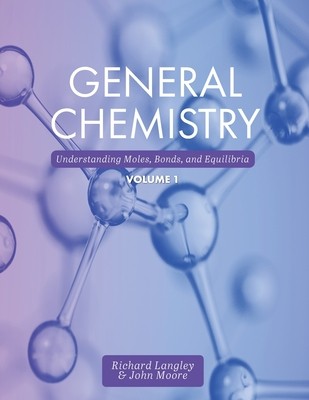
- We will send in 10–14 business days.
- Author: Richard Langley
- Publisher: Cognella Academic Publishing
- ISBN-10: 1516518756
- ISBN-13: 9781516518753
- Format: 21.6 x 27.9 x 3.3 cm, softcover
- Language: English
- SAVE -10% with code: EXTRA
Reviews
Description
General Chemistry: Understanding Moles, Bonds, and Equilibria, Volume 1 introduces students to foundational concepts in chemistry with emphasis on real-world application. Throughout the text, students learn how the study of chemistry supports material science, forensics, medicine, and other disciplines.
The text is organized into 13 chapters that can be taught traditionally or in a non-linear fashion. Topics include the scientific method, atoms, mass and molecules, aqueous solutions, gases, thermochemistry, electrons in atoms, and electron configuration. Students learn about chemical bonding, molecular geometry, liquids and solids, and mixtures.
The book features problems that span multiple chapters, topic boxes that contain worked examples, concurrent presentation of the VSEPR and Valence Bond theories to allow each to reinforce the other, and integration of environmental topics within distinct sections of appropriate chapters. Introductions, summaries, problems, application examples, and meaningful appendices further facilitate student learning, rendering General Chemistry an ideal textbook for foundational chemistry courses.
General Chemistry: Understanding Moles, Bonds, and Equilibria, Volume 2 is a continuation of this text with further coverage of equilibria, thermodynamics, nuclear chemistry, organic chemistry, and biochemistry and biotechnology.
John Moore holds an Ed.D. from Texas A&M University with an emphasis in science education. He previously served as a professor of chemistry at Stephen F. Austin State University (SFA) for 46 years and is currently working for SFA's Science, Technology, Engineering and Mathematics Center. Dr. Moore is the author of Chemistry for Dummies, Chemistry Essentials for Dummies, and Chemistry II for Dummies. He is the coauthor of Chemistry for the Utterly Confused, Biochemistry for Dummies, 5 Steps to a 5 AP Chemistry, and Must Know High School Chemistry, among other works. John has been a grader for the AP Chemistry Exam for many years.
Richard Langley holds a Ph.D. in inorganic chemistry from the University of Nebraska-Lincoln. He has taught chemistry at the university level for nearly 40 years. He is the author of 500 Physical Chemistry Questions and coauthor of 1,001 Practice Problems for Chemistry for Dummies, Chemistry for the Utterly Confused, Biochemistry for Dummies, 5 Steps to a 5 AP Chemistry, and Must Know High School Chemistry, among other works. He has been a grader for the AP Chemistry Exam for many years.
EXTRA 10 % discount with code: EXTRA
The promotion ends in 19d.16:59:13
The discount code is valid when purchasing from 10 €. Discounts do not stack.
- Author: Richard Langley
- Publisher: Cognella Academic Publishing
- ISBN-10: 1516518756
- ISBN-13: 9781516518753
- Format: 21.6 x 27.9 x 3.3 cm, softcover
- Language: English English
General Chemistry: Understanding Moles, Bonds, and Equilibria, Volume 1 introduces students to foundational concepts in chemistry with emphasis on real-world application. Throughout the text, students learn how the study of chemistry supports material science, forensics, medicine, and other disciplines.
The text is organized into 13 chapters that can be taught traditionally or in a non-linear fashion. Topics include the scientific method, atoms, mass and molecules, aqueous solutions, gases, thermochemistry, electrons in atoms, and electron configuration. Students learn about chemical bonding, molecular geometry, liquids and solids, and mixtures.
The book features problems that span multiple chapters, topic boxes that contain worked examples, concurrent presentation of the VSEPR and Valence Bond theories to allow each to reinforce the other, and integration of environmental topics within distinct sections of appropriate chapters. Introductions, summaries, problems, application examples, and meaningful appendices further facilitate student learning, rendering General Chemistry an ideal textbook for foundational chemistry courses.
General Chemistry: Understanding Moles, Bonds, and Equilibria, Volume 2 is a continuation of this text with further coverage of equilibria, thermodynamics, nuclear chemistry, organic chemistry, and biochemistry and biotechnology.
John Moore holds an Ed.D. from Texas A&M University with an emphasis in science education. He previously served as a professor of chemistry at Stephen F. Austin State University (SFA) for 46 years and is currently working for SFA's Science, Technology, Engineering and Mathematics Center. Dr. Moore is the author of Chemistry for Dummies, Chemistry Essentials for Dummies, and Chemistry II for Dummies. He is the coauthor of Chemistry for the Utterly Confused, Biochemistry for Dummies, 5 Steps to a 5 AP Chemistry, and Must Know High School Chemistry, among other works. John has been a grader for the AP Chemistry Exam for many years.
Richard Langley holds a Ph.D. in inorganic chemistry from the University of Nebraska-Lincoln. He has taught chemistry at the university level for nearly 40 years. He is the author of 500 Physical Chemistry Questions and coauthor of 1,001 Practice Problems for Chemistry for Dummies, Chemistry for the Utterly Confused, Biochemistry for Dummies, 5 Steps to a 5 AP Chemistry, and Must Know High School Chemistry, among other works. He has been a grader for the AP Chemistry Exam for many years.


Reviews